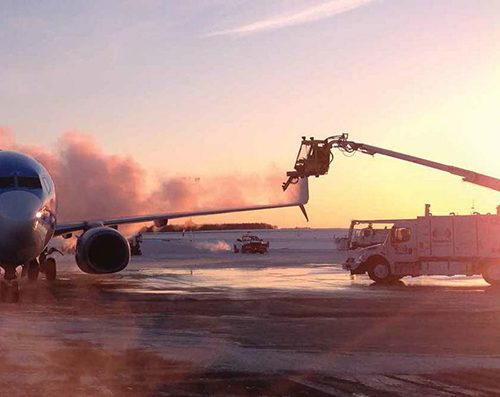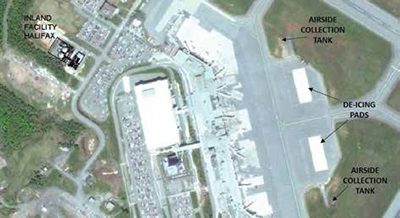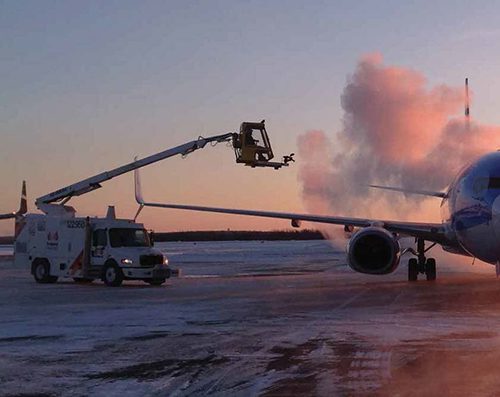Halifax Stanfield International (YHZ) is staking its claim as an industry leader in environmental management with the commissioning of a glycol recovery and distillation facility built at the Nova Scotia airport last year. The new system not only collects spent glycol from YHZ’s aircraft de-icing operations, it also recycles the liquid and uses it to produce Type I aircraft deicing fluid that is subsequently reused at the airport.
Inland Technologies, the company that has provided a variety of glycol recovery services at YHZ for the last two decades, designed and built the new system. It also owns and operates the environmentally advanced facility. Operating expenses for the system are covered by fees paid by airlines that operate at YHZ.
According to Inland personnel, the company has collected an average of 7 million liters of deicing fluid per season since it established onsite operations at the airport in 2004. The average volume of glycol that is eventually reused is trending at 650,000 liters annually. Throughout the years, the company has recycled roughly 63 million liters of deicing fluid (not including this year’s volume).
| factsfigures Project: Glycol Recovery/Recycling Location: Halifax (NS) Stanfield Int’l Airport Annual Traffic: 3.6 million passengers; 32,000 metric tons of cargo System Design & Construction: Inland Technologies How it Works: Vacuum trucks collect spent fluids from aircraft deicing operations & system distills the glycol & recycles it to produce Type I aircraft deicing fluid for reuse at the airport Avg. Volume Deicing Fluid Collected: 7 million liters/yr Avg. Volume Reused: 650,000 liters/yr Total Deicing Fluid Collected: 63 million liters (2004-2014) Of Note: Inland owns & operates the glycol recovery/distillation/recycling system; carrier fees pay for its operating expenses |
Mike Rantala, senior manager of regulatory affairs for the Halifax International Airport Authority, reflects positively on the evolution of the company’s operations at YHZ. “Since the arrival of the first glycol recovery vehicle in 1995, we’ve seen better recovery efficiency as Inland improved their methods and equipment,” says Rantala. “The volume of glycol-impacted water has decreased, while the concentration of the glycol in the material collected has increased.”
Recovering and managing the glycol from aircraft deicing is a challenge YHZ shares with airports throughout North America’s Snowbelt. For safety reasons, airlines operating in cold weather areas follow a “clean-wing” policy, which requires wing surfaces to be free of all snow and/or ice prior to takeoff. (Even a small amount can severely reduce an aircraft’s lift.) Glycol is the active ingredient in Type I deicing fluid, the heated agent sprayed onto aircraft exteriors to remove snow and ice, and Type IV anti-icing fluid, which is applied to prevent snow or ice from building up on critical surfaces.
With annual snowfalls that average 2.2 to 2.3 meters (about 86 inches), YHZ personnel are well versed in the need for both products and processes. Weather conditions that alternate between freezing and thawing further add to the glycol-impacted stormwater the Nova Scotia airport has to manage.
Like airports in all 10 provinces, YHZ must comply with the Canadian Environmental Protection Act, which limits the amount of glycol reaching stormwater to 100 milligrams per liter. Before Inland installed a recycling plant at YHZ in 2004, the airport’s contaminated stormwater was collected and disposed of off-site via biological treatment. With the addition of the recycling plant, collected effluent could be treated on-site, producing a 50% raw-grade glycol product that was sold to low-value industrial markets for re-use. After Inland’s more recent system upgrade last year, the YHZ plant now distills a 99.5% virgin quality glycol product that is reused at the airport.
Three-Step System
The custom recovery and recycling system that Inland Technologies designed for YHZ uses purpose-engineered glycol recovery vehicles to “vacuum” spent deicing fluid from the apron. Because of dilution by rain and snow, the liquid collected normally averages 5% glycol. The recovered fluid is delivered to a landside recycling plant, where the effluent is processed by Inland’s Glycol Concentrators. A third system then distills it for reuse.
 Previously, Inland used recovery vehicles produced by a third-party manufacturer. But in 2010, the company introduced its own equipment, the Glyvac(tm), to improve collection efficiency. In order to meet environmental regulations and minimize the area where aircraft deicing fluid is used, all deicing operations at YHZ take place on a pad. Glycol recovery vehicles capture effluent quickly to reduce the volume of liquid on de-icing pads, collect fluid before it is diluted and decrease associated labor and equipment fuel costs.
Previously, Inland used recovery vehicles produced by a third-party manufacturer. But in 2010, the company introduced its own equipment, the Glyvac(tm), to improve collection efficiency. In order to meet environmental regulations and minimize the area where aircraft deicing fluid is used, all deicing operations at YHZ take place on a pad. Glycol recovery vehicles capture effluent quickly to reduce the volume of liquid on de-icing pads, collect fluid before it is diluted and decrease associated labor and equipment fuel costs.
Richard Johnson, product development manager of Inland Technologies, considers the company’s specially designed recovery vehicle a key component of YHZ’s environmental program. “This custom-engineered vacuum truck maximizes chemical recovery while improving operator safety,” says Johnson.
According to Inland, the Glyvac consumes 30% to 45% less fuel than similar vehicles. It also has a 6,814-liter storage tank, which reduces offloading time to further conserve fuel and increase efficiency.
 Beyond the new recovery vehicle, Inland engineers and operations personnel developed a multi-faceted program for the YHZ facility. Key elements include a drain management system, fluid storage, fluid testing and onsite recycling of effluent via an airport-specific distillation system. Inland also installed a block-and-pump collection system to supplement Glyvac operations during extra heavy precipitation. (Halifax typically experiences 156 wet days per year). Two diversion vaults, located at the deicing pads, are used to pump effluent directly to two airside tanks. Material is then transported via tanker a short distance to the recycling facility for processing. As part of the customized approach taken at YHZ, effluent is pre-treated using a dissolved air flotation skid to remove sediment and polymers that might clog or slow the recycling process.
Beyond the new recovery vehicle, Inland engineers and operations personnel developed a multi-faceted program for the YHZ facility. Key elements include a drain management system, fluid storage, fluid testing and onsite recycling of effluent via an airport-specific distillation system. Inland also installed a block-and-pump collection system to supplement Glyvac operations during extra heavy precipitation. (Halifax typically experiences 156 wet days per year). Two diversion vaults, located at the deicing pads, are used to pump effluent directly to two airside tanks. Material is then transported via tanker a short distance to the recycling facility for processing. As part of the customized approach taken at YHZ, effluent is pre-treated using a dissolved air flotation skid to remove sediment and polymers that might clog or slow the recycling process.
From there, effluent is processed in energy-efficient Glycol Concentrators, which take raw, diluted effluent and produce a 50% glycol product. That material is then sent through the recently installed Starcevic Distillation System, which produces a 99.5% virgin quality glycol product. After the glycol is polished to remove trace contaminants, it is used to produce Inland’s certified Type I aircraft deicing fluid. When ground crews apply the fluid to aircraft departing from YHZ, the full-circle process is complete.
 Currently, water used during processing is sent for further management, but Inland is investigating options to use the distilled water at the airport. “We have always invested heavily in research and development,” says Inland President and Chief Executive Officer Roger Langille.
Currently, water used during processing is sent for further management, but Inland is investigating options to use the distilled water at the airport. “We have always invested heavily in research and development,” says Inland President and Chief Executive Officer Roger Langille.
The proximity of YHZ to the Inland’s corporate headquarters in Truro, Nova Scotia, makes the airport a natural site for equipment trials. Inland has deployed the glycol recovery technology originally tested at YHZ to numerous other airports in North America, including facilities in Washington, D.C. and Portland, ME.
While YHZ officials are pleased with recent advancements to glycol management at the airport, they hope for even more. “Inland has been a tremendous partner in helping us reach our environmental goals,” says Rantala, “We look forward to our continued partnership as we move forward with further minimizing our environmental footprint.”
Glycol recovery and recycling isn’t the only area in which YHZ distinguishes itself. The Atlantic Canadian facility was the first North American airport to offer self-service baggage drop for all passengers. It also consistently ranks high in worldwide traveler satisfaction surveys.





